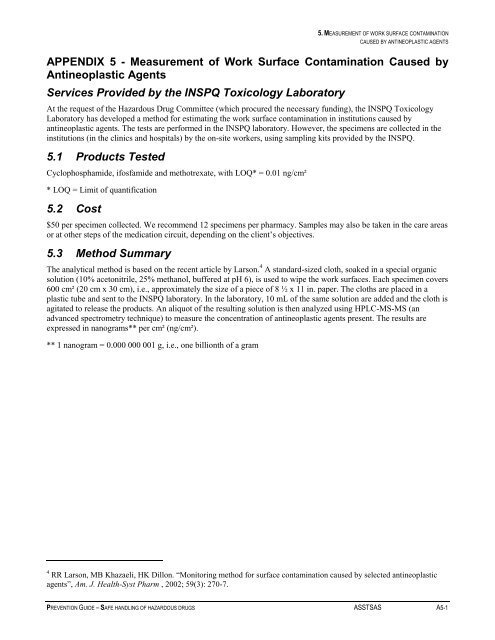Prevention Guide - Safe Handling of Hazardous Drugs - Irsst
Prevention Guide - Safe Handling of Hazardous Drugs - Irsst
Prevention Guide - Safe Handling of Hazardous Drugs - Irsst
Create successful ePaper yourself
Turn your PDF publications into a flip-book with our unique Google optimized e-Paper software.
5. MEASUREMENT OF WORK SURFACE CONTAMINATION<br />
CAUSED BY ANTINEOPLASTIC AGENTS<br />
APPENDIX 5 - Measurement <strong>of</strong> Work Surface Contamination Caused by<br />
Antineoplastic Agents<br />
Services Provided by the INSPQ Toxicology Laboratory<br />
At the request <strong>of</strong> the <strong>Hazardous</strong> Drug Committee (which procured the necessary funding), the INSPQ Toxicology<br />
Laboratory has developed a method for estimating the work surface contamination in institutions caused by<br />
antineoplastic agents. The tests are performed in the INSPQ laboratory. However, the specimens are collected in the<br />
institutions (in the clinics and hospitals) by the on-site workers, using sampling kits provided by the INSPQ.<br />
5.1 Products Tested<br />
Cyclophosphamide, ifosfamide and methotrexate, with LOQ* = 0.01 ng/cm²<br />
* LOQ = Limit <strong>of</strong> quantification<br />
5.2 Cost<br />
$50 per specimen collected. We recommend 12 specimens per pharmacy. Samples may also be taken in the care areas<br />
or at other steps <strong>of</strong> the medication circuit, depending on the client’s objectives.<br />
5.3 Method Summary<br />
The analytical method is based on the recent article by Larson. 4 A standard-sized cloth, soaked in a special organic<br />
solution (10% acetonitrile, 25% methanol, buffered at pH 6), is used to wipe the work surfaces. Each specimen covers<br />
600 cm² (20 cm x 30 cm), i.e., approximately the size <strong>of</strong> a piece <strong>of</strong> 8 ½ x 11 in. paper. The cloths are placed in a<br />
plastic tube and sent to the INSPQ laboratory. In the laboratory, 10 mL <strong>of</strong> the same solution are added and the cloth is<br />
agitated to release the products. An aliquot <strong>of</strong> the resulting solution is then analyzed using HPLC-MS-MS (an<br />
advanced spectrometry technique) to measure the concentration <strong>of</strong> antineoplastic agents present. The results are<br />
expressed in nanograms** per cm² (ng/cm²).<br />
** 1 nanogram = 0.000 000 001 g, i.e., one billionth <strong>of</strong> a gram<br />
4 RR Larson, MB Khazaeli, HK Dillon. “Monitoring method for surface contamination caused by selected antineoplastic<br />
agents”, Am. J. Health-Syst Pharm , 2002; 59(3): 270-7.<br />
PREVENTION GUIDE – SAFE HANDLING OF HAZARDOUS DRUGS ASSTSAS A5-1

















